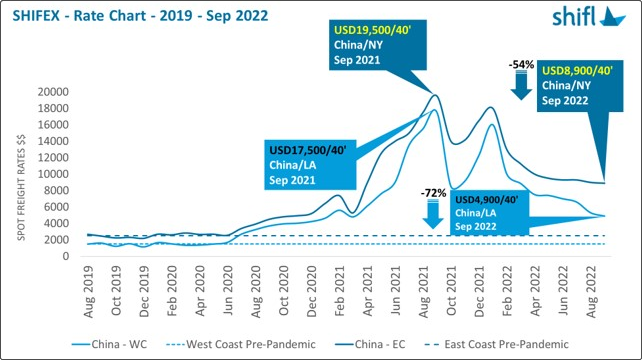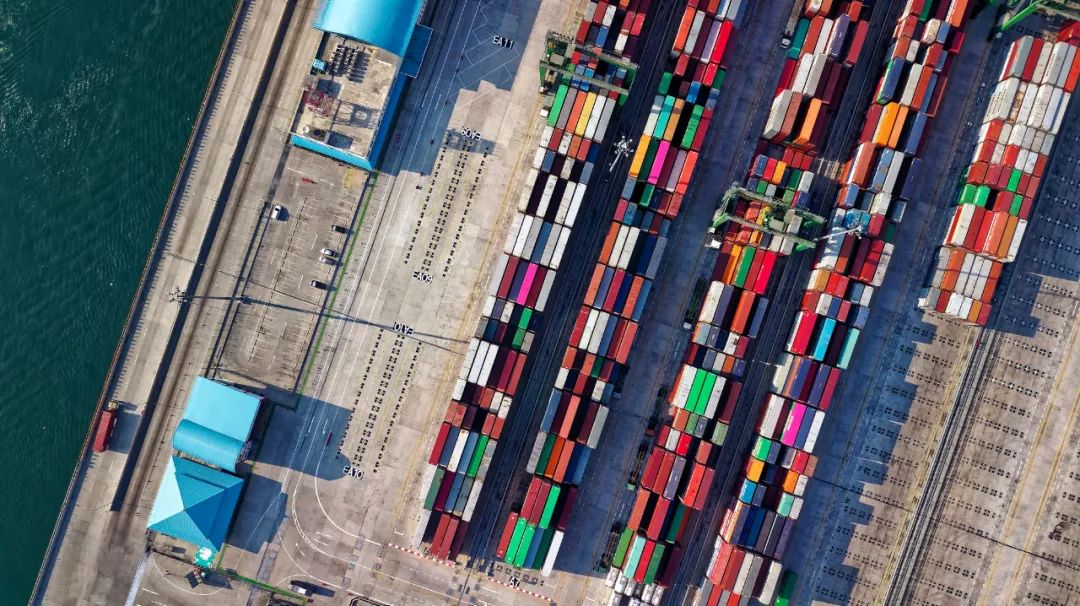Although the container shipping industry is entering the traditional peak season, spot freight rates have continued to decline and have fallen significantly compared to the same period last year.
After reporting a decline in spot freight rates for weeks, digital freight platform Shifl reported that its data analysis showed ocean freight rates for a 40-foot container from China to the U.S. west coast will fall below $5,000 for the first time since January 2021.
Shifl forecasts that the average spot freight rate between China and the U.S. will fall to $4,900/FEU in September, which would be a 72% year-on-year decline from the September 2021 high of $17,500/FEU.

The latest data from the Drewry World Container Freight Index shows that the spot freight rate from Shanghai to Los Angeles is US$6,127/FEU, a weekly decline of 6%. The FBX freight index shows that the spot freight rate from Asia to West America was US$5,759/FEU last week, down 6% from the previous week to US$390/FEU.
Shabsie Levy, CEO and founder of Shifl, said: “While spot freight rates have continued to decline, they are still more than three times higher than they were before the pandemic. However, current freight rates are much lower than at the beginning of the year when consumer demand was very high. The pace of this continued decline suggests that the market is in some way returning to a new normal.”
However, the drop in spot freight rates from China to the U.S. East Coast has been relatively modest. Shifl noted that they expect spot rates on this route to drop by 54% to $8,900/FEU in September this year, compared to $19,500 in September 2021.
According to the latest data from the Drewry World Container Freight Index, the spot freight rate from Shanghai to New York is US$9,569/FEU, down 1% from last week.

Regarding the difference in freight rates between the US West and the US East on the Far East route, Xeneta said that the current spot freight rate difference between the east and west coasts of the United States has hit a record high, because the container traffic transferred from west to east is very high due to the risk of strikes at the US West ports. huge. This has also led to increased pressure on East Coast ports and severe congestion.
In addition, Shifl predicts that the continued decline in spot prices will put continued pressure on shipping companies. Shipping companies have highlighted in their recent financial reports that long-term contract freight rates have contributed to their extraordinary profits. For major carriers such as Maersk and ONE, freight volumes fell overall in the second quarter, with multi-year contracts accounting for 70% of their container volumes, Shifl analysis said.
"As spot market rates continue to fall, shipping lines will be forced to renegotiate previously higher long-term contract rates," Levy said. "Some customers have contracts that include additional clauses tied to spot rates."
Separately, maritime data analytics firm Sea-Intelligence reports that when looking at capacity deployments on the main east-west trade lanes, it is seen that available capacity is increasing at the same time as demand growth is slowing. Vessel utilisation on the trans-Pacific route fell sharply in May and continued in June, with vessel utilisation remaining at around 89%.
Alan Murphy, CEO of Sea-Intelligence, said: “Basically, once the trans-Pacific route reaches 90% to 95% vessel utilization, it means that capacity is fully utilized and spot freight rates will increase significantly. It has now been two consecutive months for vessels Utilization rates are all below 90%, and it is clear that the market is no longer able to sustain extremely high levels of spot freight rates." "As a result, the downward trend in spot freight rates will continue." At the same time, on the Asia-Europe and transatlantic routes Saw something similar.
Previous:A large number of sellers switched to shipping! Shipping prices fell 70% from peak
Next:The excess demand in the container shipping market has almost disappeared, and the gap between deman